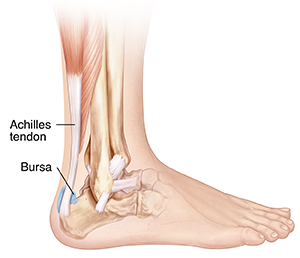Understanding Retrocalcaneal Bursitis
Retrocalcaneal bursitis is a condition that causes heel pain. This pain spreads from the bursa located between the Achilles tendon and the heel bone. This bursa normally provides a cushion as you walk.
A bursa is a fluid-filled sac. Your body has many of them. They are found in areas where rubbing may occur, such as between tendons and bones. The fluid inside them helps ease friction during movement. If they become injured or irritated, you may feel pain.

How to say it
reht-troh-kal-KAY-nee-uhl ber-SI-tihs
What causes retrocalcaneal bursitis?
This type of bursitis is mainly caused by using the ankle a lot, such as running uphill. A sudden increase in running or similar activities can also lead to it. Athletes who wear tight-fitting shoes while practicing or exercising are more prone to the condition. So, too, are those who don’t stretch or warm up properly before such activities. Some cases may result from an infection or a disease such as arthritis.
Symptoms of retrocalcaneal bursitis
Severe pain and swelling in the back of the heel are typical symptoms. You may also notice tenderness when the heel is touched. Tight-fitting shoes may become hard to wear. You may hear a crackling sound when you flex your foot.
Treatment for retrocalcaneal bursitis
The aim of treatment is to ease symptoms so that the bursa has time to heal. Treatment may include:
-
Rest. You may need to alter or limit activities that cause heel pain. These include high-impact activities like running.
-
Prescription or over-the-counter medicines. These help reduce pain and swelling. NSAIDs (nonsteroidal anti-inflammatory drugs) are the most common medicines used. Medicines may be prescribed or bought over the counter. They may be given as pills. Or they may be put on the skin as a gel, cream, or patch.
-
Cold packs or heat packs. These may ease pain.
-
Shoe inserts or padding. Devices such as heel cups or pads for the back of your heel can ease discomfort when moving.
-
Footwear. Don't wear tight-fitting shoes or those that rub the back of your heel. Shoes with an open-back heel, such as clogs, may help.
-
Stretching exercises. Gentle stretching movements can restore flexibility in your ankle and foot. They can also help with pain.
-
Steroid injection. A needle is used to inject a pain reliever and steroid into the affected bursa. This shot can relieve pain and reduce swelling for several weeks.
-
Surgery. This treatment is rarely needed unless other options don’t work.
Possible complications of retrocalcaneal bursitis
-
Limited range of motion in the affected foot and ankle
-
Infected bursa
When to call your healthcare provider
Call your healthcare provider right away if you have any of these:
-
Fever of 100.4°F (38°C) or higher, or as advised by your provider
- Chills
-
Pain that gets worse
-
Symptoms that don’t get better, or get worse
-
New symptoms